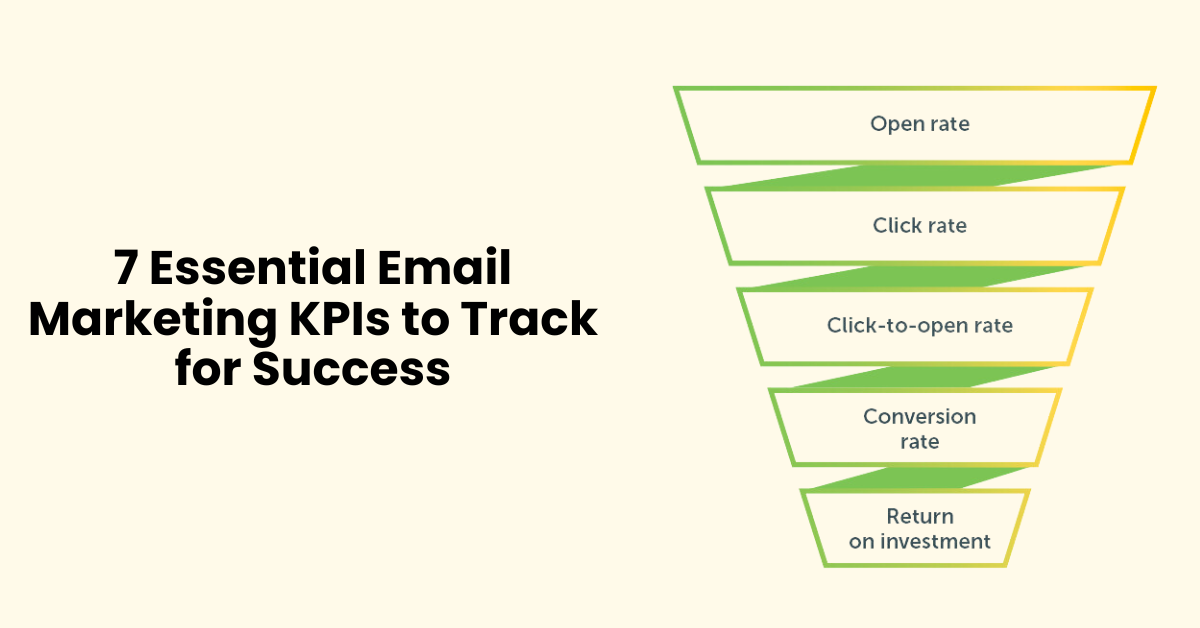7 Essential Email Marketing KPIs to Track for Success

In the dynamic world of digital marketing, where every click and open matters, email marketing emerges as a powerful tool to engage customers, nurture leads, and drive sales. However, measuring the effectiveness of your email campaigns can be a daunting task, especially amidst the vast sea of email marketing metrics and data.
To help you navigate this intricate landscape, we've embarked on a journey to uncover the 7 essential email marketing KPIs that will transform your campaigns into success stories. Embrace these key performance indicators and unveil the true potential of your email marketing efforts.
The Role of Email Marketing in E-commerce Growth
Email marketing holds a pivotal role in the growth and success of e-commerce businesses. At its core, it serves as a direct and personalized communication channel between brands and their customers. This is especially crucial in e-commerce, where building and maintaining customer relationships can significantly impact sales and growth.
The power of email marketing in e-commerce lies in its ability to keep customers informed and engaged. It's a tool that can announce new products, offer special promotions, and share valuable content, directly contributing to driving sales. Moreover, it helps in nurturing long-term customer relationships by providing a platform for ongoing engagement and personalized communication.
Here are the 7 Best KPIs for email marketing to track your success:
KPI #1: Open Rate
Open Rate is a fundamental KPI in email marketing, especially crucial for growth marketers. It measures the percentage of recipients who open an email, providing a clear indication of how compelling your email appears in your audience's inbox. Essentially, a high open rate signals that your subject lines are resonating with your audience, grabbing their attention amidst a sea of emails.
Improving the open rate is key to enhancing the overall effectiveness of your email campaigns. One effective strategy is to craft captivating, concise, and relevant subject lines. These should spark curiosity or offer clear value, compelling recipients to explore further. Personalizing subject lines can also make a significant difference. Including the recipient's name or references to their interests can make emails feel more tailored and less like mass communication.
Another tactic is to optimize the send time of your emails. Analyzing when your audience is most likely to check their inbox and scheduling your emails accordingly can greatly increase the chances of them being opened.
KPI #2: Click-Through Rate (CTR)
Click-Through Rate (CTR) is one of the most critical email marketing KPIs particularly relevant for growth marketers in the e-commerce sector. It measures the percentage of email recipients who clicked on one or more links contained in an email. Essentially, CTR is a direct indicator of how well your email content resonates with your audience and incites action. A high CTR means recipients find your emails relevant and engaging enough to explore further.
Improving CTR requires a focus on crafting more compelling email content. This includes designing clear and enticing call-to-actions (CTAs), using persuasive language, and ensuring that the content is directly relevant to the recipients' interests or needs. Personalization plays a key role here. By tailoring the email content to align with the recipient's previous interactions with your brand or their expressed preferences, you can significantly increase the chances of them clicking through.
KPI #3: Conversion Rate
Conversion Rate is the one of the most important email marketing KPIs in especially pertinent for growth marketers in the e-commerce domain. Simply put, the conversion rate measures the percentage of email recipients who completed a desired action, such as making a purchase or signing up for a webinar, after clicking on a link in the email. This KPI directly correlates with the effectiveness of your email campaigns in driving tangible business results.
A high conversion rate indicates that your email content resonates well with your audience and effectively motivates them to take action. Conversely, a low conversion rate may suggest a need for improvement in various aspects of your emails, like the call-to-action, content relevance, or overall design.
To Improve Conversion Rates:
- Personalization: Tailor your email content to meet the specific interests and needs of your audience. Personalized emails tend to have a higher conversion rate as they are more relevant to the recipient.
- Strong Call-to-Action (CTA): Ensure your CTA is clear, compelling, and easy to find. A well-defined CTA guides the recipient towards the desired action.
- Segmentation: Segment your email list to target different groups with messages that are most relevant to them. This increases the likelihood of conversions.
- A/B Testing: Regularly test different elements of your emails (like subject lines, email layouts, and CTAs) to see what works best with your audience and refine your approach accordingly.
KPI #4: Bounce Rate
Bounce rate, a critical KPI for email marketing, essentially measures the percentage of your sent emails that are not successfully delivered to recipients' inboxes. It's categorized into two types: 'hard bounces,' which occur when the email is sent to an invalid address, and 'soft bounces,' typically resulting from temporary issues like a full inbox or a server problem.
A high bounce rate is a red flag in email marketing, indicating issues in your email list quality or email deliverability. It's crucial for growth marketers to keep this rate as low as possible to ensure their campaigns reach their intended audience effectively.
Improving Bounce Rate:
- Regular Email List Cleaning: Routinely remove invalid or inactive email addresses from your list. This process helps in reducing hard bounces.
- Verification at Sign-Up: Implement email verification during the sign-up process to ensure that the email addresses collected are valid.
- Monitor Engagement: Keep an eye on subscriber engagement and consider removing or re-engaging subscribers who haven't opened emails over an extended period.
- Understand Email Provider Rules: Different email providers have their own set of rules for spam and delivery. Understanding these can help tailor your emails to avoid being flagged or rejected.
KPI #5: Unsubscribe Rate
The unsubscribe rate in email marketing is a straightforward yet telling metric. It indicates the percentage of recipients who opt out of your mailing list after receiving an email. While it's natural for any list to experience some level of attrition, a high unsubscribe rate can signal deeper issues, such as content that doesn't resonate with your audience or too frequent communications.
For growth marketers, keeping the unsubscribe rate low is essential. It's not just about retaining numbers, but about maintaining a base of interested, engaged subscribers who find value in your emails. High unsubscribe rates can lead to a smaller audience and, consequently, fewer opportunities for conversions and growth.
To improve this email marketing KPI, consider the following strategies:
- Segmentation: Tailor your content to different segments of your audience to ensure relevance.
- Frequency Optimization: Find the right balance in how often you send emails. Too many can overwhelm subscribers, too few can make them forget about your brand.
- Quality Content: Provide valuable, engaging content that meets your subscribers' needs and interests.
- Feedback Mechanisms: Include options for feedback in your emails to understand why people might unsubscribe and address those issues.
KPI #6: List Growth Rate
List growth rate is a crucial email marketing KPI for growth marketers in the realm of email marketing. Simply put, it measures how quickly your email list is expanding over a specific period. This email marketing metric & KPIs is vital because a growing list signifies new opportunities to reach potential customers, increasing the potential for sales and brand expansion.
To calculate the List Growth Rate, you subtract the number of unsubscribes from the number of new subscribers, then divide that number by the total number of email addresses on your list, and finally multiply by 100 to get a percentage. A positive growth rate indicates a healthy, expanding email list, while a stagnant or negative rate may signal a need for revised strategies to attract new subscribers.
Improving List Growth Rate:
- Optimize Website Sign-Ups: Make it easy and enticing for visitors to subscribe, with visible sign-up forms and incentives like discounts or exclusive content.
- Leverage Social Media: Promote your email list on social media platforms, highlighting the exclusive benefits of joining.
- Referral Programs: Encourage current subscribers to refer friends in exchange for rewards, thereby leveraging existing relationships to build your list.
- Quality Content: Ensure that the content you provide via emails is valuable and relevant, as this encourages subscribers to share your emails, bringing in new subscribers.
KPI #7: Email Sharing/Forwarding Rate
Email Sharing/Forwarding Rate is a less talked about but significant Key Performance Indicator (KPI) in email marketing. Essentially, it measures how often recipients are forwarding or sharing your email content with others. This KPI is a direct indicator of the relevance and appeal of your content. A high sharing rate not only extends your email's reach beyond the original mailing list but also serves as an endorsement of your content's value.
For growth marketers, understanding and improving this rate is crucial. It's not just about reaching more people; it's about reaching the right people through trusted referrals. High sharing rates can exponentially increase your brand's visibility and credibility.
To improve this KPI, focus on creating genuinely engaging and valuable content that resonates with your audience. Content that provides unique insights, helpful tips, or exclusive offers is more likely to be shared. Encouraging sharing can also be as straightforward as including clear and easy-to-use sharing buttons in your emails. Additionally, crafting emails that speak directly to your primary audience's interests encourages them to share it with like-minded individuals, thus amplifying your message organically.
How to drive conversions using email automation by BIK?
Driving conversions using email automation with a tool like BIK involves several strategic steps:
- Segment Your Audience: Use BIK to segment your audience based on their behaviors, interests, and past interactions with your emails. This allows for more targeted and personalized email campaigns.
- Personalize Your Emails: Utilize BIK’s capabilities to personalize your emails. This includes using the recipient’s name, referencing their past purchases, or suggesting products based on their browsing history.
- Automated Trigger Emails: Set up automated emails triggered by specific actions, such as cart abandonment or a recent purchase. BIK can help in sending timely and relevant follow-up emails to nudge customers towards making a purchase.
- Optimize Send Times: Use BIK’s analytics to determine the best times to send emails, maximizing the likelihood of opens and engagement. Sending emails when your audience is most likely to be checking their inbox can greatly increase conversion rates.
- A/B Testing: Regularly test different elements of your emails (like subject lines, email design, CTA buttons) using BIK’s A/B testing tools. This helps in understanding what works best with your audience and refining your approach for higher conversions.
- Monitor Performance Metrics: Keep an eye on key performance indicators such as open rates, click-through rates, and conversion rates. BIK’s analytics tools can provide valuable insights into the effectiveness of your campaigns.
- Refine and Repeat: Use the data and insights gathered from BIK to continuously refine your email marketing strategy. Adapt your content, personalization, and timing based on what the data shows is most effective.
- Leverage Content Effectively: Ensure your email content is engaging and provides value. Include clear and compelling calls to action that guide subscribers towards making a purchase.
- Utilize Upselling and Cross-Selling Techniques: Use BIK to identify opportunities for upselling and cross-selling. Recommend products that complement what your customers have already shown interest in or have purchased.
Conclusion
In conclusion, mastering email marketing campaign KPIs is essential for any growth marketer in the e-commerce sector. By diligently tracking and analyzing these seven key performance indicators, you can gain invaluable insights into your campaign's effectiveness. This knowledge not only helps in fine-tuning your strategies for better engagement and conversions but also plays a critical role in driving the overall growth and success of your e-commerce brand.

.png)
